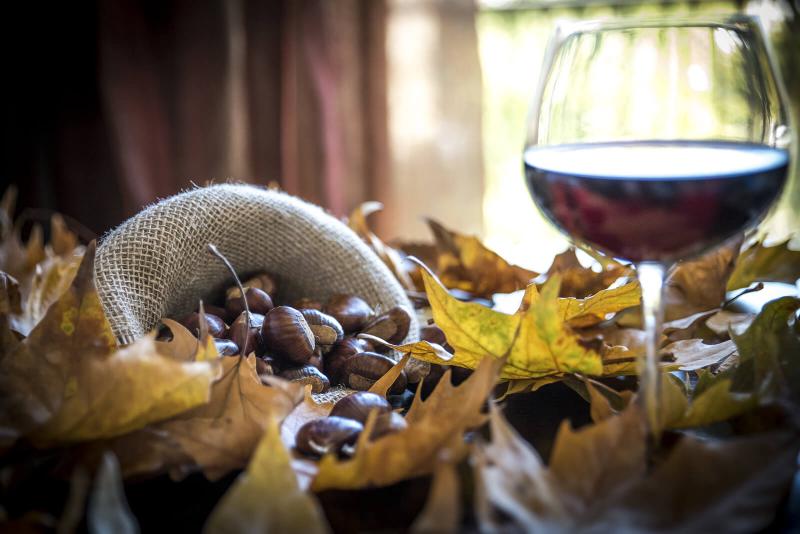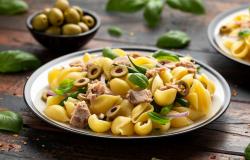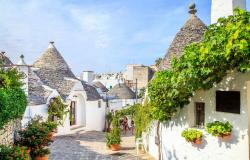Chestnuts and Wine: A Match Made in Heaven
ITA:

Use player to listen to Italian version
“A San Martino castagne e vino.” Chestnuts and wine on the Feast of Saint Martin. It’s a saying you will often hear in Italy as St. Martin’s Day, November 11, approaches.
St. Martin’s Day is celebrated in honor of Christian saint Martin of Tours, but the tradition that puts together chestnuts and wine has nothing to do with him – rather, it is a symbolic date connected to the rhythms of agriculture, marking the transition from the farmers’ working season to a period of rest.
For their work, peasants received the products available in the season and, in the fall, there was nothing more precious than chestnuts and wine.
Chestnuts were in the past a fundamental food for the sustenance of shepherds and farmers. So important that the chestnut tree was nicknamed ‘the bread tree’.
Nutritious and filling, chestnuts were cooked, roasted, boiled, used in desserts or turned into flour to make bread. They were so precious to be used as barter goods in areas where they could not be found. They were often bartered with another precious good, which in the past was considered not just a drink, but a food: wine.
For this reason, it was essential to have the wine ready by mid-November.
“On St. Martin’s Day, every must becomes wine,” is another recurring saying you hear this time of the year that tells about another essential transition phase in the life of farmers: the maturation of the new wine.
Vino Novello (New Wine) was born from the need to have the wine ready quickly. Vino Novello is a light, fruity, red wine produced throughout Italy, which can only be marketed starting on October 30, and must be consumed within a few months after bottling, or its characteristics will deteriorate. Tradition says that the last days to consume it are ‘i giorni della merla,’ the days of the blackbird, said to be the coldest days of the year (29–31 January).
Vino Novello and chestnuts make for a perfect match and, traveling throughout Italy, you’re likely to find a celebration of the Feast of Saint Martin revolving around these two ingredients.
On this occasion, chestnuts are roasted and served with a glass of Novello wine, and, over the centuries, wine has become not just an accompaniment to the chestnuts, but an integral part for the preparation of the roasted chestnuts themselves.
Traditions vary from north to south: some leave chestnuts soaking in water and wine before cooking, others serve them directly inside a glass of new wine once roasted, others still cook them in wine.
So if you’re in Italy during this time, make sure you try the special taste of roasted chestnuts and red novello wine!
“A San Martino castagne e vino.” È un detto che in Italia ti capiterà di sentire spesso quando si avvicina il giorno di San Martino, l'11 novembre.
La Festa di San Martino è celebrata in onore del santo cristiano Martin di Tours, ma la tradizione che unisce castagne e vino non ha nulla a che fare con lui - piuttosto, è una data simbolica legata ai ritmi dell'agricoltura, che segna il passaggio dalla stagione lavorativa degli agricoltori a un periodo di riposo.
In cambio del loro lavoro, i contadini ricevevano i prodotti disponibili durante la stagione e, in autunno, non c'era niente di più prezioso delle castagne e del vino.
Le castagne erano in passato un alimento fondamentale per il sostentamento di pastori e contadini. Così importanti che il castagno fu soprannominato ‘l'albero del pane’.
Nutrienti e ricche, le castagne venivano cotte, arrostite, bollite, usate nei dolci o trasformate in farina per fare il pane. Erano così preziose da essere usate come beni di scambio in aree dove queste non si trovavano. Erano spesso scambiate con un altro bene prezioso, che in passato era considerato non solo una bevanda, ma un cibo: il vino.
Per questo motivo, era essenziale avere il vino pronto entro la metà di novembre.
“A San Martino, ogni mosto diventa vino” è un altro detto ricorrente di questo periodo dell'anno che racconta un'altra fase essenziale di transizione nella vita degli agricoltori: la maturazione del vino nuovo.
Il vino novello nasce dall'esigenza di avere il vino pronto in fretta. Il vino novello è un vino rosso leggero, fruttato, prodotto in tutta Italia, che può essere commercializzato solo a partire dal 30 ottobre e deve essere consumato entro pochi mesi dall'imbottigliamento, altrimenti le sue caratteristiche si deteriorano. La tradizione dice che gli ultimi giorni per consumarlo sono ‘i giorni della merla’, che si dice siano i giorni più freddi dell'anno (29-31 gennaio).
Il vino novello e le castagne sono perfetti insieme e, in tutta Italia, è facile trovare una celebrazione della Festa di San Martino che ruota intorno a questi due ingredienti.
In questa occasione, le castagne vengono arrostite e servite con un bicchiere di vino novello; nel corso del tempo, il vino non è diventato solo un accompagnamento alle castagne, ma parte integrante nella preparazione delle castagne stesse.
Le tradizioni variano da nord a sud: alcuni lasciano le castagne immerse in acqua e vino prima della cottura, altri le servono direttamente in un bicchiere di vino novello dopo che sono state tostate, altri ancora le cuociono nel vino.
Quindi se sei in Italia in questo periodo, assicurati di provare il gusto speciale delle castagne arrostite e del vino novello!











